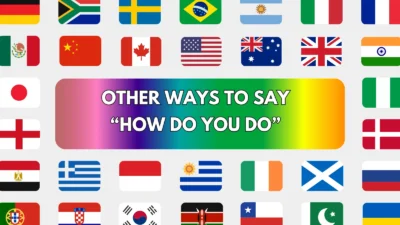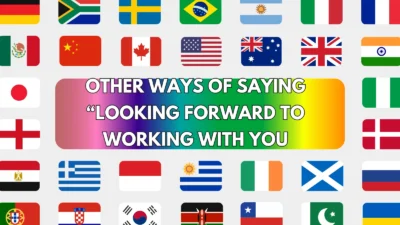The phrase “For your information” (FYI) is commonly used to share details, updates, or facts that someone should know. It’s direct and clear — but sometimes it can sound too formal, distant, or even slightly curt depending on the context. Choosing alternative expressions can make your message sound more natural, polite, or conversational.
Here are 25 other ways to say “For your information,” each explained with meaning, tone, examples, and when best to use them.
1. Just so you know
Meaning: Casually informs someone of something useful or important.
Detailed Explanation: A friendly and conversational phrase often used in informal communication.
Scenario Example: Just so you know, the meeting’s been moved to 3 PM.
Best Use: Everyday conversation, text, or chat.
Tone: Informal, polite.
2. I wanted to let you know
Meaning: Shares information gently and respectfully.
Detailed Explanation: Softens the message and shows courtesy.
Scenario Example: I wanted to let you know that your package has been shipped.
Best Use: Emails, customer service, professional updates.
Tone: Polite, considerate.
3. For your reference
Meaning: Provides information that may be useful later.
Detailed Explanation: Common in formal writing, especially when sharing data or documents.
Scenario Example: Please find the attached report for your reference.
Best Use: Professional communication, documentation.
Tone: Formal, respectful.
4. In case you weren’t aware
Meaning: Politely informs someone about something they may not know.
Detailed Explanation: Works well when you want to avoid sounding condescending.
Scenario Example: In case you weren’t aware, the deadline has been extended.
Best Use: Emails, workplace discussions.
Tone: Neutral, professional.
5. Just to keep you updated
Meaning: Provides ongoing information or updates.
Detailed Explanation: Adds a sense of communication and transparency.
Scenario Example: Just to keep you updated, the project is now in the testing phase.
Best Use: Status reports, teamwork, collaborations.
Tone: Friendly, informative.
6. As a heads-up
Meaning: Warns or informs someone about something in advance.
Detailed Explanation: Shows you care about keeping them informed before something happens.
Scenario Example: As a heads-up, traffic might be heavy tomorrow morning.
Best Use: Informal or semi-formal settings.
Tone: Cautionary, friendly.
7. Thought you might like to know
Meaning: Shares information that may interest or benefit the person.
Detailed Explanation: Makes the message feel personal and thoughtful.
Scenario Example: Thought you might like to know that your article got featured today!
Best Use: Friendly emails, chats.
Tone: Warm, conversational.
8. For your awareness
Meaning: Shares facts or updates to ensure understanding.
Detailed Explanation: Common in business contexts when communication clarity is important.
Scenario Example: For your awareness, maintenance will take place this weekend.
Best Use: Corporate communication, memos.
Tone: Professional, direct.
9. To keep you in the loop
Meaning: Keeps someone informed of developments.
Detailed Explanation: Often used in collaborative projects to maintain transparency.
Scenario Example: To keep you in the loop, we’ve changed the supplier for this batch.
Best Use: Work updates, teamwork emails.
Tone: Casual, cooperative.
10. Just a quick note to say
Meaning: Introduces short, useful information politely.
Detailed Explanation: Works well in friendly or semi-formal messages.
Scenario Example: Just a quick note to say the files are uploaded now.
Best Use: Short professional emails, reminders.
Tone: Friendly, concise.
11. In case it helps
Meaning: Shares information that might be useful.
Detailed Explanation: Shows humility and helpfulness rather than authority.
Scenario Example: In case it helps, I’ve attached a summary of our discussion.
Best Use: Team support, email attachments.
Tone: Supportive, thoughtful.
12. Just passing this along
Meaning: Forwards or shares information from another source.
Detailed Explanation: Clarifies that you’re simply relaying details, not originating them.
Scenario Example: Just passing this along — the client updated the schedule.
Best Use: Office communication, forwarded messages.
Tone: Neutral, efficient.
13. Kindly note
Meaning: Politely draws attention to important information.
Detailed Explanation: Common in formal or written communication.
Scenario Example: Kindly note that office hours will change next week.
Best Use: Professional, administrative notices.
Tone: Formal, courteous.
14. For your convenience
Meaning: Shares information to make things easier for someone.
Detailed Explanation: Often used when providing helpful resources or attachments.
Scenario Example: For your convenience, I’ve included a printable version of the form.
Best Use: Customer service, professional emails.
Tone: Polite, service-oriented.
15. So that you’re aware
Meaning: Ensures the person is informed about something relevant.
Detailed Explanation: Adds clarity while remaining polite.
Scenario Example: So that you’re aware, the event location has changed.
Best Use: Informative updates.
Tone: Neutral, professional.
16. To keep you informed
Meaning: Shares information to maintain communication.
Detailed Explanation: Great for progress updates and transparency.
Scenario Example: To keep you informed, we’ll be rolling out changes next week.
Best Use: Business reports, client updates.
Tone: Professional, factual.
17. As a reminder
Meaning: Refers to something already communicated.
Detailed Explanation: Gently reinforces important information or deadlines.
Scenario Example: As a reminder, submissions close on Friday.
Best Use: Follow-ups, deadlines, events.
Tone: Polite, neutral.
18. Just bringing this to your attention
Meaning: Politely highlights something that needs notice.
Detailed Explanation: Used when you want someone to be aware of an issue or update.
Scenario Example: Just bringing this to your attention — there’s been a billing error.
Best Use: Workplace communication.
Tone: Courteous, attentive.
19. I thought I’d share
Meaning: Offers information voluntarily.
Detailed Explanation: Sounds friendly and considerate.
Scenario Example: I thought I’d share the client feedback with you — it’s very positive!
Best Use: Team messages, friendly exchanges.
Tone: Personal, kind.
20. For your consideration
Meaning: Provides information to help with decision-making.
Detailed Explanation: Often used in formal proposals or documents.
Scenario Example: Attached are three design options for your consideration.
Best Use: Business proposals, emails, official documents.
Tone: Formal, respectful.
21. To give you a heads-up
Meaning: Alerts someone before something happens.
Detailed Explanation: Helps others prepare for upcoming events or changes.
Scenario Example: To give you a heads-up, the server will be down tonight.
Best Use: Team coordination, announcements.
Tone: Informal, proactive.
22. Please be advised
Meaning: Officially informs someone about something.
Detailed Explanation: Standard in legal or formal communication.
Scenario Example: Please be advised that the office will be closed on Monday.
Best Use: Legal, administrative, or HR communication.
Tone: Formal, authoritative.
23. As a point of information
Meaning: Introduces relevant facts in a professional manner.
Detailed Explanation: Helps frame data or clarify discussions formally.
Scenario Example: As a point of information, our budget was approved yesterday.
Best Use: Meetings, reports, formal discussions.
Tone: Academic, official.
24. For the record
Meaning: Adds an official or factual statement.
Detailed Explanation: Used to clarify or confirm information in discussions.
Scenario Example: For the record, we completed the project two days early.
Best Use: Professional or public settings.
Tone: Formal, factual.
25. Just to clarify
Meaning: Adds or corrects information to ensure understanding.
Detailed Explanation: Useful for removing confusion or confirming facts.
Scenario Example: Just to clarify, the deadline is next Friday, not this one.
Best Use: Emails, meetings, team communication.
Tone: Neutral, clear.
Conclusion
“For your information” is useful, but tone and context matter. Whether you’re writing an email, chatting with a coworker, or addressing clients, choosing the right phrase can help you sound more natural, polite, and approachable.
From “Just so you know” to “Kindly note” or “To keep you informed,” these 25 alternatives let you share information effectively — while keeping communication friendly and professional.



